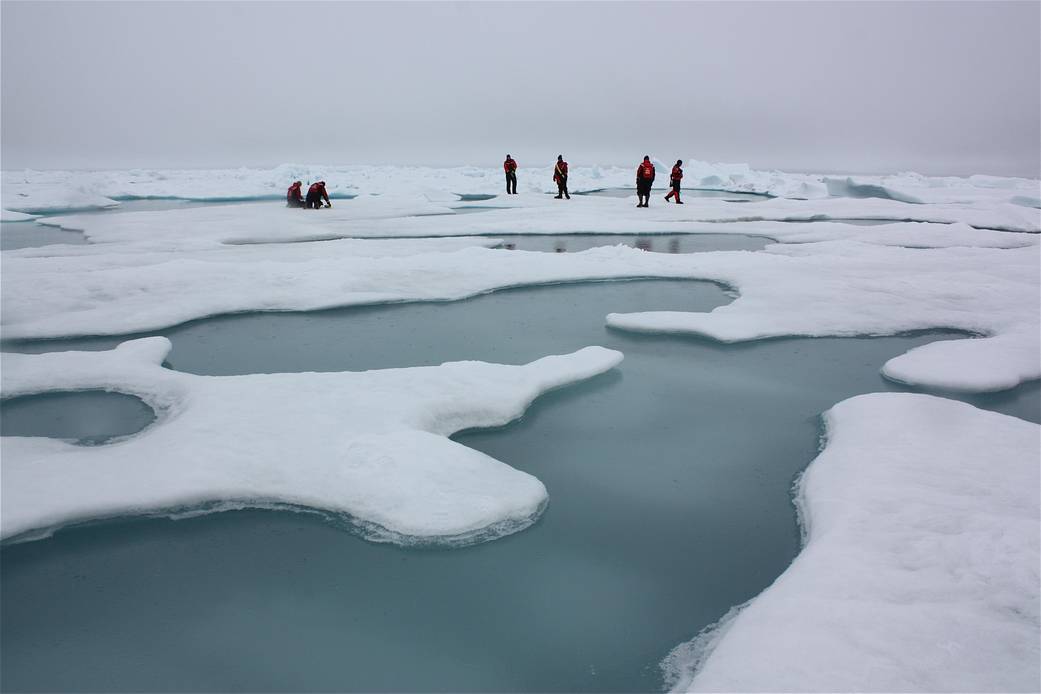U.S. executive order on oceans neglects the Arctic, expert says
Trump's oceans executive order, like the Obama document it supplants, doesn't mention the world's fastest-changing ocean.

In June 2018, President Trump signed a new executive order on ocean policy that highlights maritime business.
It replaced a previous executive order on oceans issued by President Obama in 2010 and focused on conservation and climate change in U.S. oceans and lakes.
But the new executive order had one thing in common with the old one: It doesn’t mention the Arctic at all.
Much like the National Defense Strategy and the National Security Strategy, both updated for 2018, the Arctic is conspicuously absent.
Rear Admiral David Titley, who is retired from the Navy and now directs the Center for Solutions to Weather and Climate Risk at the Pennsylvania State University, calls the omission “a missed opportunity.”
“We kind of forgot about the place that’s changing the fastest in the world,” he said at a recent event on marine policy at the Woodrow Wilson Center.
“Or maybe we didn’t forget,” he added. “But it’s not in there.”
Titley prefaced his comments with the half-joke that he neither receives nor seeks federal funding, and “that allows me to say what I think.”
“The Arctic is changing, and it’s actually changing faster than any other region in the world right now,” Titley said.
But without addressing the region, and the challenges facing it, it will be difficult to make progress, he said.
“It’s really hard to fix something if you don’t at least identify what the challenge is,” Titley said.
Those challenges, he said, include rapid and unprecedented changes in the environment, growing security concerns, and an uptick in shipping and transportation.
Although President Obama’s executive order did not focus on the Arctic specifically, it did focus upon conservation and climate change — key issues in the region.
Oceans and coastlines are of particular importance, Titley said.
“The water is changing, in which we have too much and too little and it’s in the wrong place at the wrong time. It’s now salty where it used to be fresh, wet where it used to be dry, liquid where it used to be solid,” he explained.
“We are changing the climate, which is changing the oceans, which is changing the world in fundamental ways that we have not seen in human civilization,” Titley said.
Such changes also open the region up to increased traffic — from military to commercial vessels.
“Our great power rivals,” Titley said, “are not neglecting the Arctic.” Russia is ramping up its military activity, while China has its sights set on a “polar silk road.”
Titley highlighted Svalbard and Greenland as the “largest geopolitical wildcards,” noting especially the possibility of Greenland’s independence.
“Do they become independent? At what rate does that happen? And if they become independent,” he asked, “who’s going to support them? Who are they going to turn to?”
China, he said, is certainly paying attention.
The new executive order focused in large part upon encouraging maritime businesses, like shipping. That, too, has consequences for the Arctic.
Titley said he had lost count of how many times he’d heard shipping executives decry the possibility of Arctic shipping.
Yet, he says, Maersk just ran their first container vessel through the Northern Sea Route.
“There are real possibilities in 10, 15, 25 years that at least seasonally — and maybe more than that, with ice-hardened ships and ice-strengthened ships — we are going to see significant traffic” in the Arctic, he said.
Last February, he pointed out, an LNG tanker transited the Northern Sea Route with no icebreaker escort.
“These are harbingers of the world that we have ahead of us,” Titley said. By neglecting climate, security, and economic changes in the Arctic, the federal government is missing an opportunity to be proactive in the region, he said.
“The good news is,” Titley said, “there’s nothing in there that precludes Arctic initiatives.”
The order simply lacks guidance on how to plan for and conduct such initiatives.